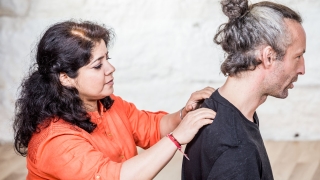
Marma Therapy & Your Energy Body
Indu talks about the Ayurvedic healing modality of Marma Therapy for cleansing blocked energy, and how it can help on your healing journey. In conversation with Dr. Avanti Kumar Singh. The Healing Catalyst podcast

![]() 4 minutes
4 minutes
Every study and deep dive requires us to create space and to honor certain rules—or as we know them in Yoga, yamas and niyamas. If you ever attended a Yoga/Ayurveda training online or you plan to, you will appreciate these tips.
In every possible scenario, maintain your conduct as if you are attending an in-person session. These 10 recommendations, suggestions, and expectations are only focused on one goal: Make the online study a pleasant, beneficial, and impactful experience for each of the participants. Each of these is based on Yama and Niyama laid out in Patanjali Yoga Sutras to help us understand their purpose.
+1. Read Seth Godin’s tips on Zoom/skype calls.
Upcoming Virtual trainings:
Pranayama Training, Starting Sept 22, 2023

Indu talks about the Ayurvedic healing modality of Marma Therapy for cleansing blocked energy, and how it can help on your healing journey. In conversation with Dr. Avanti Kumar Singh. The Healing Catalyst podcast

When we say “Yoga Nidra,” what is the meaning of the word, “Nidra?” “Sleep?” But it is incomplete if I just say that Nidra= sleep. There is so much more to it and we may be missing the point. There is also a prefix to this and that is “Yoga.” ...

Holi is the ultimate festival of colors from India. Surrounded by family, friends and community, we celebrate with food, colors and flowers the arrival of spring. Among these external layers of rituals and festivities lies the underlying current of Ayurveda, Tantra and Yoga. Every festival in India is a multilayered celebration. Let us see how these five layers unveil their colors on Holi.